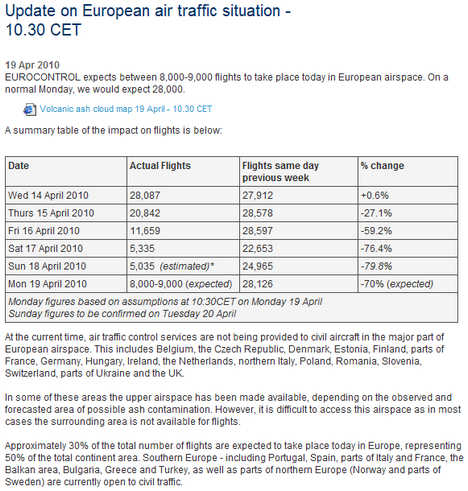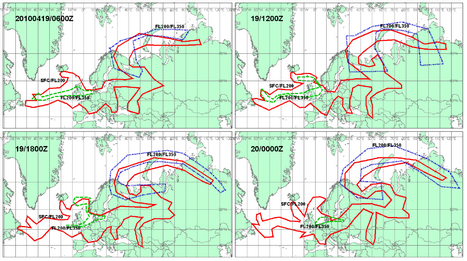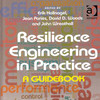 Today is Day Five of the infamous Iceland volcanic ash cloud disruption. What just a week ago was a highly improbable scenario has settled in to become a daily routine…almost. Was this really one of these damned (Pardon my French) Black Swan Events…or was it a Predictable Surprise we should have been aware of? While it is fair to assume that volcanic eruptions are in the business continuity plans of most airlines, it is probably not so fair to assume that 5 days of sudden air traffic restrictions is in the business continuity plans of most companies reliant on frequent air travel. Perhaps it should have been. For sure it will be – from now on.
Today is Day Five of the infamous Iceland volcanic ash cloud disruption. What just a week ago was a highly improbable scenario has settled in to become a daily routine…almost. Was this really one of these damned (Pardon my French) Black Swan Events…or was it a Predictable Surprise we should have been aware of? While it is fair to assume that volcanic eruptions are in the business continuity plans of most airlines, it is probably not so fair to assume that 5 days of sudden air traffic restrictions is in the business continuity plans of most companies reliant on frequent air travel. Perhaps it should have been. For sure it will be – from now on.
How much longer?
When I first posted on this, 5 days ago, my post Today’s transport disruption: Volcanoes wasn’t meant to be that serious, which is why I went back to my old posting track on supply chain risk literature the day after. As that day passed I realized that this is a situation that is likely going to stay for a while, both in the air and on my blog, and it is a situation that will put business continuity and resilience to the ultimate test. The scenario described in an article in the German newspaper Die Welt looks like it’s becoming a reality: Was ist wenn die Wolke länger bleibt? or What if the cloud stays longer? as I translated it on my blog yesterday.
Business continuity
Business continuity, according to Wikipedia, is
the activity performed by an organization to ensure that critical business functions will be available to customers, suppliers, regulators, and other entities that must have access to those functions.
Many countries, like the UK, have a Business Continuity Act in place, others, like my own country, Norway do not. Here, 7 out of 10 are without a business continuity plan. And even if they do, a one-week no-fly scenario is most likely not going to be in it. A 5-day stop in production or operations maybe, but not an airport shut-down lasting 5 days.
Do we really need air traffic?
For one ting, this incident has shown how interconnected the airline systems is globally, much like the global shipping network, and how a incident in Europe can hamper traffic in the US and in Asia, and it shows that at any time there are tens of thousands of people on the way from somewhere to somewhere else. Europe alone has more than 30000 flights daily, and if we assume a conservative passenger load of 100 per airplane that makes 3 million business travelers and holiday makers in the air during any given day.

Yesterday I asked he timely question Can we do without air traffic? Can we?
Airlines cannot survive without flying
Secondly, this incident also shows how dependent airlines are on keeping their planes flying. No flights, no cash. After all, a flight is not something you can produce and stock somewhere. It is produced and instantly consumed at the same time. Cash in from one flight, is money in the bank for the next flight. Without passengers and without fligths, no airline can survive, sparking emergency talks on the impacts of the volcanic ash cloud in the EU. And airlines themselves are conducting test flights, so far without incidents.
Supply chain disruptions
Usually, supply chain risk due to natural hazards is caused by a natural hazard being located close to the supply chain. In this case the natural hazard is far from the supply chain, which is a scenario not contained in most crisis management plans. No flights also means no air freight, and at the airports exporting goods destined for Europe stores and warehouses are probably full to the rim by now, and fresh flowers and vegetables destined for the European market in danger of perishing. Perhaps time now to think about the security of supply? In turn, this may have widespread ramifications for the exporters, e.g. producers having to lay off staff, or even going out of business, as if the aftermath of the recession wasn’t enough. We haven’t heard much about the business impacts yet, because so far the focus has been on getting people home.

However, I do expect to hear demands for government actions (i.e. bailouts) soon. And, I do expect to see businesses and perhaps also insurance companies suing civil aviation authorities for closing too many airports, causing them to lose money or even go out of business.
Nature: 1, Humans: 0
For what its worth, this incident has clearly demonstrated that despite all our modern technology, there’s something hat’s bigger than us and that always has the upper hand: Nature always wins.
Links
- news.bbc.co.uk: EU emergency talks on volcanic ash cloud
- guardian.co.uk: We need to get people home
- tv2nyhetene.no: Kortvarig glede
- vg.no: Endelig kommer vi hjem
- vg.no: Asken vil dekke hele Norge
Related
- husdal.com: Business continuity in global supply chains
- husdal.com: Supply chain risk in global supply chains
- husdal.com: Business Continuity Handbook












